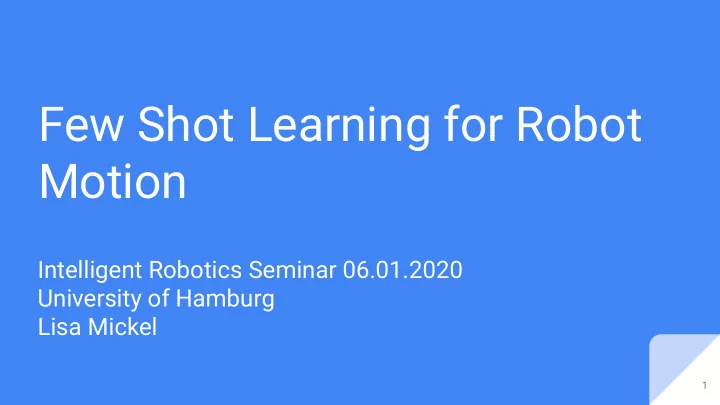

Few Shot Learning for Robot Motion Intelligent Robotics Seminar 06.01.2020 University of Hamburg Lisa Mickel 1
Content ● Introduction ● Reinforcement learning Approach 1: Model free maximum entropy ● Approach 2: Model based ● ● Results: Simulation and real-life ● Comparison & conclusion 2
Reinforcement Learning ● Markov Decision Process (MDP): ○ State and action space Transition probability ○ ○ Policy s t+1 r ○ Reward function a t ● Model free: learn policy π (a t |s t ) Model based: learn transition ● π (a t |s t ) probability p(s t+1 |s t , a t ) s t p(s t+1 |s t , a t ) [3] 4
Approach 1: Learning to Walk via Deep Reinforcement Learning ● Model free algorithms often limited to simulation ● Extension of maximum entropy Haarnoja , Ha , Zhou , Tan, Tucker, learning Levine Google Brain, University of California, Berkeley Jun 2019 5
A1: Maximum Entropy Learning ● Entropy = measure for variance Encourage exploration by including entropy of policy ● Hyperparameter α = temperature ○ ○ Training results dependent on its value ● New approach: learn temperature Add constraint: Minimum expected entropy H of policy π ○ 6
A1: System Setup On robot: ● ○ Execute policy Workstation Robot Measure robot state ○ ○ Compute reward signal Data Training: policy collection: Update policy & Workstation ● a t, s t temperature ○ Train with sample from buffer Update policy (neural network) ○ parameters and temperature sample Motion Replay Buffer trajectory capture: s t+1 , r 7
Approach 2: Data Efficient Reinforcement Learning for Legged Robots ● Model based few shot RL algorithm Yang, Caluwaerts, Iscen, Zhang, Tan, Sindhwani Robotics at Google United States Oct 2019 8
A2: System Setup MPC: plan action based on ● dynamics model → execute plan Current robot state as ● feedback, periodically replan Periodic retraining with all ● trajectories [A2] 9
A2: Planning Control frequency > planning frequency ● ○ Simultaneous planning and execution of actions Planning horizon: 450 ms (=75 control steps), replan every 72 ms ○ ● Planning latency → plan based on future robot state (asynchronous control) [A2] 10
A2: Training Dynamics model: Neural network ● Long term accuracy of dynamics model: multi-step loss function ● Predict n states and average over single step error → accumulation of error ● 11
A2 Trajectory Generators Smooth robot motion ● → Trajectory generators (TGs) ● Periodically lift legs 4 independent phases ● → Freely modulate leg movements independently [A2] 12
Results: Simulation ● Goal: ○ A1: Walk straight ○ A2: Walk forward matching speed profile [A1] 13
A1: Performance ● Several benchmark tests [A1] Compare to standard algorithms → A1 matches best performance ● ● Best on minitaur robot 14
A1: Influence of hyperparameter on performance ● SAC: Temperature = inverse reward ● A1: Minimum expected entropy scale [A1] 15
A2: Performance ● Comparison to model free ● Influence of algorithm components algorithms on performance [A2] 17
Results: Real-Life [A1] 18
A1: Training Video [v1] 19
A2: Training Video [v2] 20
Training Results Approach A1 A2 Walking speed 0.32 m/s (0.8 body 0.66 m/s (1.6 body lengths/s) lengths/s) Steps 160 000 45 000 Episodes 400 36 21
A1: Generalization [v3] 22
A2: Generalization [v2] 23
Comparison Approach A1 A2 Gait Learns sinusoidal pattern, Adapts sinusoidal pattern of different front and hind leg TGs frequency Higher walking speed Data efficiency Better than standard SAC Better than A1 Hyperparameters Minimum expected entropy Planning algorithm, multi step loss (simulation) Gait generalizability Slope, step, obstacle Slope New tasks Range of applicability Various robots Problem specific Adaptability? 24
Conclusion and Outlook ● Two data efficient reinforcement algorithms that successfully train real-life minitaur robot to walk ● Future work: ○ Additional sensors → more complex behaviours ○ Safety measures → larger robots 25
Thank you for your attention! 26
References A1: Tuomas Haarnoja,, Sehoon Ha , Aurick Zhou , Jie Tan, George Tucker, Sergey Levine; Learning to Walk via Deep Reinforcement Learning ; arXiv:1812.11103v3 [cs.LG]; Jun 2019 A2: Yuxiang Yang, Ken Caluwaerts, Atil Iscen, Tingnan Zhang, Jie Tan, Vikas Sindhwani; Data Efficient Reinforcement Learning for Legged Robots ; arXiv:1907.03613v2 ; Oct 2019 Other: https://towardsdatascience.com/introduction-to-various-reinforcement-learning-algorithms-i-q-l ● earning-sarsa-dqn-ddpg-72a5e0cb6287 https://en.wikipedia.org/wiki/Reinforcement_learning ● ● https://spinningup.openai.com/en/latest/algorithms/sac.html https://en.wikipedia.org/wiki/Markov_decision_process ● 27
Image Sources [1] https://newatlas.com/anymal-quadruped-robot-eth-zurich/52097/ [2] https://www.hackster.io/news/meet-ghost-minitaur-a-quadruped-robot-that-climbs-fences-and-opens- doors-bfec23debdf4 [3] https://en.wikipedia.org/wiki/Reinforcement_learning 28
Video links [v1] https://www.youtube.com/watch?time_continue=4&v=FmMPHL3TcrE&feature=emb_logo [v2] https://www.youtube.com/watch?v=oB9IXKmdGhc&feature=youtu.be [v3] https://www.youtube.com/watch?v=KOObeIjzXTY&feature=emb_logo 29
Recommend
More recommend